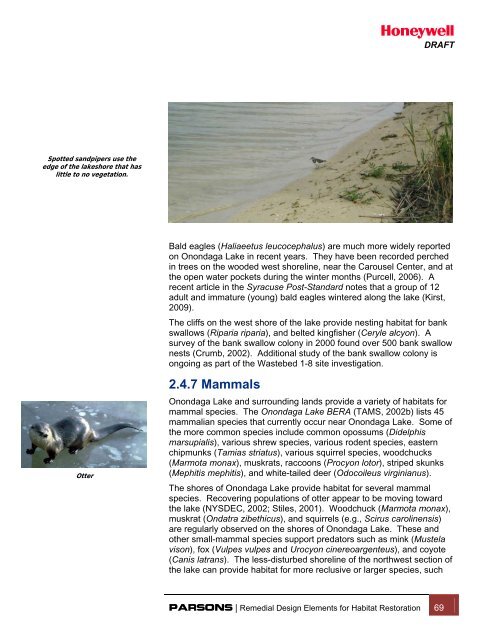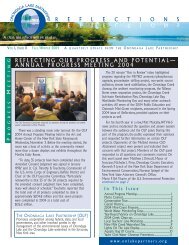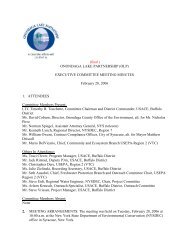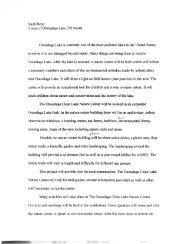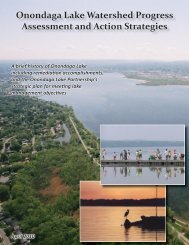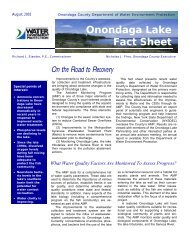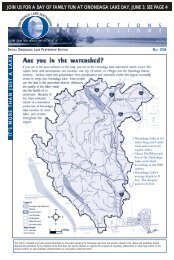Habitat Plan 2 - Onondaga Lake Partnership
Habitat Plan 2 - Onondaga Lake Partnership
Habitat Plan 2 - Onondaga Lake Partnership
Create successful ePaper yourself
Turn your PDF publications into a flip-book with our unique Google optimized e-Paper software.
DRAFTSpotted sandpipers use theedge of the lakeshore that haslittle to no vegetation.OtterBald eagles (Haliaeetus leucocephalus) are much more widely reportedon <strong>Onondaga</strong> <strong>Lake</strong> in recent years. They have been recorded perchedin trees on the wooded west shoreline, near the Carousel Center, and atthe open water pockets during the winter months (Purcell, 2006). Arecent article in the Syracuse Post-Standard notes that a group of 12adult and immature (young) bald eagles wintered along the lake (Kirst,2009).The cliffs on the west shore of the lake provide nesting habitat for bankswallows (Riparia riparia), and belted kingfisher (Ceryle alcyon). Asurvey of the bank swallow colony in 2000 found over 500 bank swallownests (Crumb, 2002). Additional study of the bank swallow colony isongoing as part of the Wastebed 1-8 site investigation.2.4.7 Mammals<strong>Onondaga</strong> <strong>Lake</strong> and surrounding lands provide a variety of habitats formammal species. The <strong>Onondaga</strong> <strong>Lake</strong> BERA (TAMS, 2002b) lists 45mammalian species that currently occur near <strong>Onondaga</strong> <strong>Lake</strong>. Some ofthe more common species include common opossums (Didelphismarsupialis), various shrew species, various rodent species, easternchipmunks (Tamias striatus), various squirrel species, woodchucks(Marmota monax), muskrats, raccoons (Procyon lotor), striped skunks(Mephitis mephitis), and white-tailed deer (Odocoileus virginianus).The shores of <strong>Onondaga</strong> <strong>Lake</strong> provide habitat for several mammalspecies. Recovering populations of otter appear to be moving towardthe lake (NYSDEC, 2002; Stiles, 2001). Woodchuck (Marmota monax),muskrat (Ondatra zibethicus), and squirrels (e.g., Scirus carolinensis)are regularly observed on the shores of <strong>Onondaga</strong> <strong>Lake</strong>. These andother small-mammal species support predators such as mink (Mustelavison), fox (Vulpes vulpes and Urocyon cinereoargenteus), and coyote(Canis latrans). The less-disturbed shoreline of the northwest section ofthe lake can provide habitat for more reclusive or larger species, suchPARSONS | Remedial Design Elements for <strong>Habitat</strong> Restoration 69


